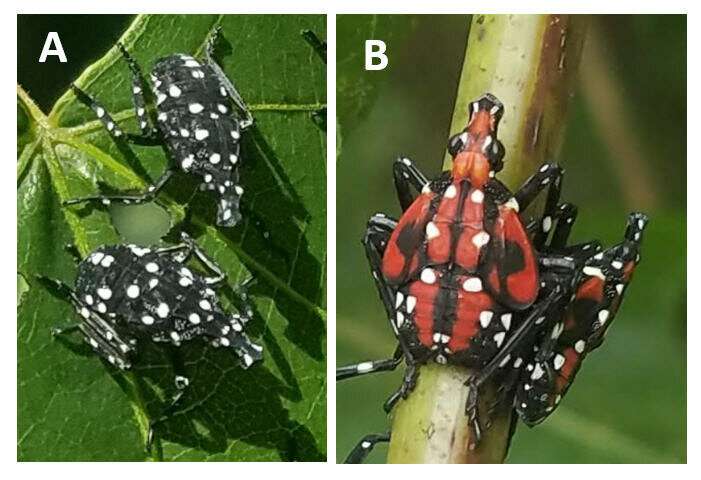You are what you eat: A color-changing insect modifies diet to become distasteful

When young spotted lanternflies grow, they become bright red. Around this time, they also begin to feed almost exclusively on the so-called tree of heaven, from which they suck bitter juices. In this way, they coordinate the moment when they become bright and visible to predators with the time when they become distasteful to predators. Birds learn to avoid bitter prey when the prey are brightly colored.
An article in Scientific Reports shows that a new invasive insect, the spotted lanternfly (Lycorma delicatula; Fig. 1), can contribute to a better understanding of prey defense against predators. This insect has been extensively studied by entomologists worldwide, but nobody has paid much attention to its evolution. It is well known that many plant-eating insects deposit some of the plant chemicals in their bodies to make themselves toxic or distasteful to predators. It is also well known that many of these insects are brightly colored in order to clearly advertise their distastefulness to predators. But only a few organisms, such as the common caterpillars or grasshoppers, have been studied in detail, and these were all we knew until recently. Among the brightly colored lanternflies, mostly living in tropical jungles, one species, the spotted lanternfly, has become invasive. Their colors were spotted by undergraduate students in Korea.
According to this recent study, when spotted lanternflies suck juice from the tree of heaven (Ailanthus altissima), the bitter ailanthone-based juice makes them distasteful: Birds do not like them, and may vomit after eating them. "You really can taste the bitterness yourself if you lick or bite on the insect yourself,: says Dr. Piotr Jablonski, who actually tasted both the surface of the insect cuticle and the interior of the insects. Dr. Sung Won Kwon and a graduate student Shinae Kim from the College of Pharmacy, Seoul National University, were able to discover that after feeding on the tree of heaven, the insects store bitter substances from the tree in their bodies.
"Thanks to an undergraduate student Soorim Song, who became the first co-author of the study, we have evidence that birds avoid lanternflies that feed on the tree of heaven because those insect taste bad to the birds," says Dr. Sang-im Lee from Daegu Gyeonbuk Institute of Science and Technology (DGIST).
When young lanternflies grow, there is a period when they become brightly red. Around this time, they also become very choosy in their diet and start feeding mostly on the tree of heaven. In this way, they coordinate the moment when they become bright and visible to predators with the time when they become distasteful to predators. Birds quickly learn to avoid bitter prey when the prey are brightly colored, and this research showed that coordinated changes in color, host plant preferences, and diet are needed to protect the insects from predators.
Later in life, when they become adults, they signal their distastefulness with red-hindwing displays, as reported two years ago by researchers from the same lab. Some other species of tropical lanternfly also include conspicuously colored nymphs and adult wing displays, and the authors believe that studies on the spotted lanternfly shed a light on the behavior of other lanternfllies, most of which live in inaccessible tropical jungles where similar studies would have been much more difficult. Probably because of these difficulties, this is the first published proof that lanternflies accumulate specific chemicals from plant juices to protect themselves from predators.
More information:
Soorim Song et al. Defense sequestration associated with narrowing of diet and ontogenetic change to aposematic colours in the spotted lanternfly, Scientific Reports (2018). DOI: 10.1038/s41598-018-34946-y
Provided by Seoul National University